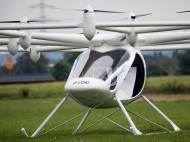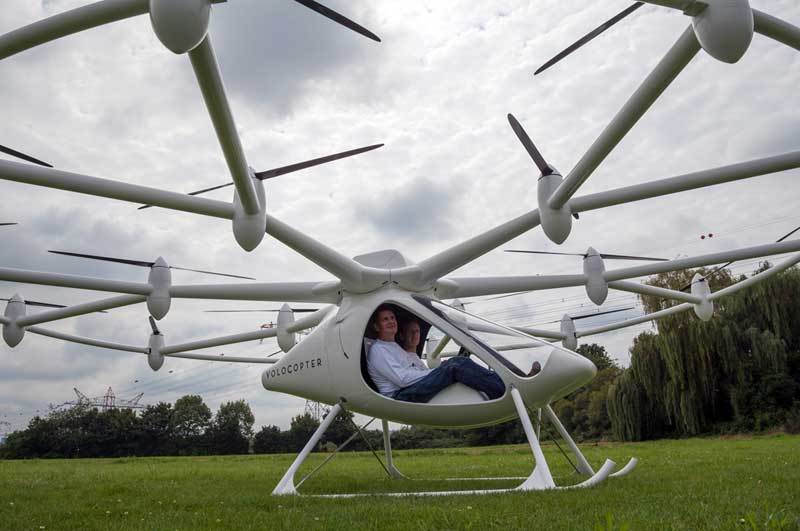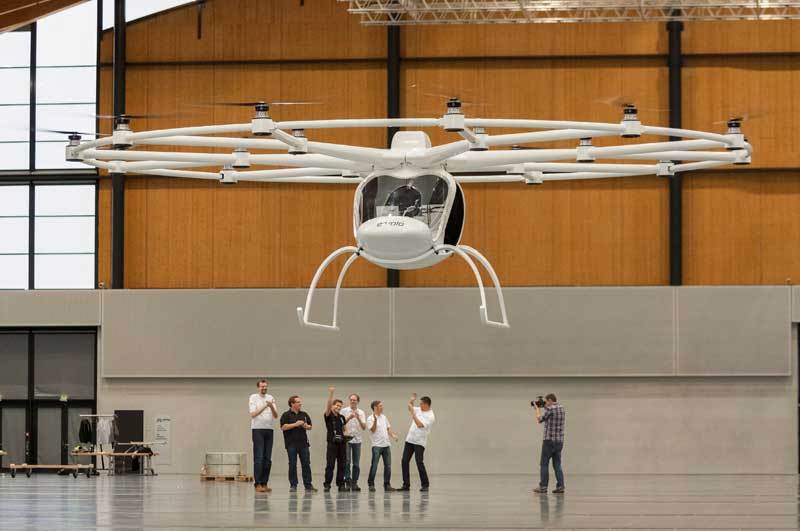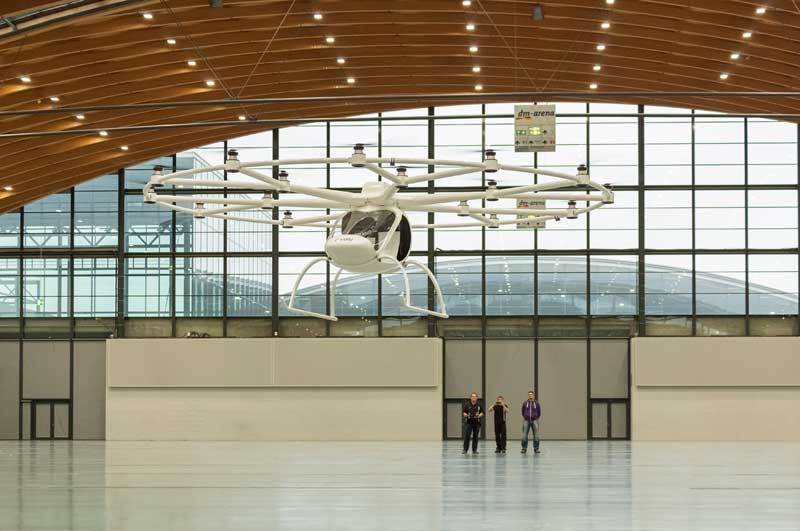e-volo Volocopter VC200 – two-person rotor aircraft
 Two years ago we reported about e-volo’s electric multicopter which performed its first manned flight. Although it appeared a bit makeshift, its development involved a lot of engineering. Recently, they unveiled e-volo’s Volocopter VC200 – a prototype two-person rotor aircraft. Improvements in its design are easily noticeable and its performance is much better compared to the first prototype, but there’s still some room for improvement.
Two years ago we reported about e-volo’s electric multicopter which performed its first manned flight. Although it appeared a bit makeshift, its development involved a lot of engineering. Recently, they unveiled e-volo’s Volocopter VC200 – a prototype two-person rotor aircraft. Improvements in its design are easily noticeable and its performance is much better compared to the first prototype, but there’s still some room for improvement.
Volocopter VC200 performed its maiden flight and first test flights were conducted in the dm-arena in Karlsruhe, on November 17, 2013. Volocopter is an environmentally friendly and emission-free rotor aircraft. Instead of one combustion engine, 18 electrically driven rotors are used for propelling and unique way of moving.
Volocopter VC200 rotor aircraft is expected to have a cruising speed of at least 100 km/h (54 kn), a flight altitude of up to 1,980 meters (6,500 feet), a maximum take-off weight of 450 kg (992 pounds), and a flight time longer than an hour. Current achievements aren’t on par with mentioned performance, but most of the goals seem achievable.
Due to elaborate simulations at the Stuttgart University, e-volo team already knew that it was much less noisy than a helicopter. However, lower-than-expected noise level exhibited during first flights caused great cheering among the e-volo team members.
“The result of the first flight created euphoria among the entire project team”, said Stephan Wolf, e-volo managing director. “Not even the HD video cameras secured to the exterior carbon ring of the rotor plane captured the least vibrations.”
Through use of its many propellers, Volocopter can perform vertical take off, to move in any direction, or to remain stationary in the air like a helicopter. Aside having simpler construction without complex mechanics, its redundancy of drives enables Volocopters to land safely even if some drives fail. The propellers generate the entire ascending force, and selective change in rotary speed allows simultaneous control of steering which is achieved with a joystick.
The automatic position control and the directional control take place by means of several independent and mutually monitoring airborne computers which control the rotation speed of each drive separately. It is very easy to fly by joystick, and it’s easier to master Volocopter flying compared to helicopters.
Topping the previous flight time of minute and a half with their first prototype, they managed to achieve multiple flights which lasted several minutes. In these flights they reached the nearly 22-meter (72-foot) high ceiling of the dm-arena where they tested the aircraft.
You might think that those results aren’t that impressive since they had a lot of time to improve Volocopter, and you’re right. Current Volocopter VC200 actually has a battery flight time of 20 minutes, but its developers expect that it could fly for more than an hour in near future. There are many breakthroughs in battery technology, and we might expect lighter batteries with more capacity within next couple of years.
Until we get the needed advancements in energy storage technology, e-volo team imagines Volocopter as a hybrid electrical aircraft with a range extender (such as an internal combustion engine) which enables flight time of several hours right from the start.
The YouTube ID of tNulEa8LTHI#t=134 is invalid.Although it looks a lot better than their proof of concept e-volo VC1 from two years ago, and added construction lowers the vibrations and increases the structural integrity of Volocopter VC200, the very same construction could also interfere with the stability of its flight in windy weather.
If several drive units or the range extender fail, a safe landing is ensured by the rest of the drive units and additional batteries. In case of emergency, Volocopter is fitted with a parachute which lets the entire aircraft to land safely on the ground in the case of an emergency.
After extensive endurance testing of the passenger cabin, the landing framework and the rotor array, VC200 will be granted a provisional airworthiness certificate. If the trial program proves successful, Volocopter VC200 could enter serial production.












This looks like it would be much easier to fly than a conventional helicopter or airplane. I might get a pilot’s license after all.
On the other side, I don’t know if I want hundreds of these things flying all around us.
Look how much extra weight goes into the structure to be able to house all of the extra rotors. It looks more than a bit ridiculous.
author
The weight shouldn’t be a problem since the aircraft is bu8ilt mostly out of carbon-fibers and plexiglass. Blades are also made from carbon-fiber, and each of these blades weights 0.5 kg (1.1 pounds).
As I emphasized in the text, potential problems may lay in the very light weight of the aircraft and the surface of the structure which houses the rotors which may hinder Volocopter’s performance when it’s windy.
There’s a lot of its design they’ll polish before it becomes available.
They could even make the seat moveable in order to enable better balance (and equal load on propellers) when there’s only one person flying the aircraft. On the other hand, they could use gyros to compensate the changes in controls during flight – a solution that also solves the problem when one person significantly outweighs their companion. However, I believe they should use additional (weight) sensors to ensure stable takeoffs.
The design is from smaller Radio controlled versions such as the “hex-copter” or “quad-copters” that you see in hobby shops and the internet. I personally own 3 quad copters (all different sizes) and the concept works. The learning curve on piloting these are not difficult as well. Unlike a conventional helicopter less manipulation is required to control it.
A helicopter has a collective pitch main blade, this simply means that in order to lift the aircraft off the ground the pilot must manually adjust rotor pitch.
The Volocopter’s blades are a fixed pitch design that rely on the speed of it’s brush less motors to create lift. Obviously the higher the speed, the more lift.
A helicopter has to manipulate the entire rotor disk to get it to either go forward, back, left, right etc. This is achieved by a smaller disk called a swash plate.
The volocopter does not need the above mentioned mechanics. It only needs to decrease the rpm’s of it motors on the opposite side to make it turn, left, right, forward, back etc.
A helicopter has to have a way to cancel out the forces of it’s main blade. The tail rotor or rear blades do this but are controlled via foot pedals. Like the main rotor these are collective pitch and require manipulation in addition to the above.
So in summary, a helicopter has more physics involved to achieve stable flight. The pilot must be moving both hands (the collective and the cyclic-stick) both legs (rear collective pitch rotor).
I like helicopters and respect the design. I also see a promising future when looking at the volocopter. Do the math: in a helicopter more is moving=more to fail. With a multi rotor design: less is moving but even if 2-3 of those motor pods fail it will still maintain flight.
Hello Dear management
We are a large company in Iran with technical knowledge and expertise, sufficient human force are high
We would like your company to represent our products to our Torah is the robot vehicle
A robot that can carry passengers edema
We are happy to be the exclusive distributor in the Middle East
Exclusive agent to sell your products in neighboring countries
Our company has a capital place
Technical knowledge
Here there are nearly 100 million client
Thanks
Mr. Myrmhmdlv
Iran
Tehran
Damad
Opposite Hosseinieh Guidance
No. 1088
00989121141892